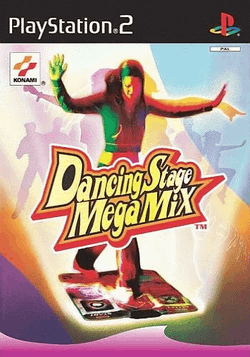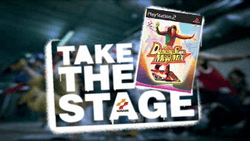Dancing Stage MegaMix
| Dancing Stage MegaMix | |
|---|---|
 | |
| Developer(s) | Konami |
| Publisher(s) | Konami |
| Series | Dance Dance Revolution, Bemani |
| Engine | 7thMix PlayStation 2 |
| Platform(s) | PlayStation 2 |
| Release date(s) |
‹See Tfd›
‹See Tfd›
|
| Genre(s) | Music & Exercise |
| Mode(s) | Single-player, multiplayer |
Dancing Stage MegaMiX is the fifth home release in the Dancing Stage series, a European version of the Dance Dance Revolution series of music video games. MegaMix was the first Dancing Stage game released on the Sony PlayStation 2 game console - and as with Dancing Stage EuroMix 2, MegaMix introduced many new features to Europe, such as Freeze Arrows, the Options menu, and a cleaner interface. Based largely on Dancing Stage EuroMix 2, MegaMiX was separated from the arcade game by a completely different track list of songs. The game was marketed by Konami as a family game and an exercise tool in efforts to make the niche series more mainstream.[1]
Gameplay
The gameplay of Dancing Stage MegaMiX is exactly like Dancing Stage EuroMIX 2, which had been released the previous year. Players who had not played EuroMIX 2 would be introduced to Konami's "Freeze Arrow" in this game, where players have to step on the correct arrow and hold their foot down until the game signaled to release it. This added more dynamics to the overall gameplay of MegaMiX and introduced situations where the player is forced to hold one foot down and hit a series of arrows solely with the other foot, maintaining balance at the same time. For beginner players MegaMiX was the first console title to feature the Beginner difficulty level, containing the absolute easiest steps possible for a song, never featuring anything beyond the most simple of step patterns, and utilizing an on-screen guide to assist
Dancing Stage MegaMiX uses the exact two-tiered scoring system that EuroMIX 2 does, but the judgment is less forgiving than EuroMIX 2, however there is a slightly larger window for perfects making it easier to pass a song overall.[2]
As with EuroMIX 2, Dancing Stage MegaMiX was based on the Japanese release DDRMAX2: Dance Dance Revolution 7thMIX, but with modifications such as difficulty selection being done before the song instead of being offered before the song wheel (but being changeable with codes). Challenge Mode[3] was replaced with Nonstop Mode, again to mimic EuroMIX 2. In total, the gameplay modes include the traditional game and nonstop modes, Workout Mode, Lesson Mode (containing tutorials), Training Mode (allowing the player to practice specific portions of songs), and Endless Mode, most of these modes and one additional song are unlocked through regular play.[4]
Modifiers
Unlike EuroMIX 2, Dancing Stage MegaMiX implements the new Options Menu which debuted on DDRMAX: Dance Dance Revolution 6thMIX, allowing easier access to modifiers which required special codes entered on the difficulty selection screen on previous versions.[4]
Interface & graphics
The visual interface was completely overhauled for the console Dancing Stage series.[5] For the first time the game played at 60fps and doubled the old video resolution from 320x240 to 640x480. Full motion background videos completely replaced the aging background animation engine, and Konami's signature dancing characters were omitted from the game for the first time on a European home version. Graphical karaoke style lyrics are displayed during some songs when there are spoken words. Occasionally videos are specifically made for a certain song, and in Dancing Stage MegaMiX's case, some licensed tracks contain their original music video in the background.[6]
Music
Note: Below the songs and courses are color-coded, ordered, and displayed as they appeared in-game as accurately as possible with the available references.
| Dancing Stage MegaMiX default song list[4][7] | |
|---|---|
| Song | Artist |
| Love at First Sight | Kylie Minogue |
| One Step Closer | S Club Juniors |
| Shake UR Body | Shy FX & T-Power feat. Di |
| When You Look At Me | Christina Milian |
| A Little Less Conversation (Elvis vs JXL) | Elvis vs JXL |
| Stealin' Beats | Kid Galahad |
| The Lovecats | The Cure |
| BRILLIANT 2U (Orchestra-Groove) | NAOKI |
| BROKEN MY HEART | NAOKI feat. PAULA TERRY |
| CRASH! | mr.BRAIN & THE FINAL BAND |
| DROP THE BOMB -System S.F. Mix- | Scotty D. |
| Groove 2001 | Sho-T feat. Blenda |
| I Was The One | good-cool |
| Kind Lady | OKUYATOS |
| Let the beat hit em! BM IIDX version | Stone Bros. |
| MEMORIES | NAOKI feat. PAULA TERRY |
| MY SUMMER LOVE | mitsu-O! with GEILA |
| PARANOiA KCET (clean mix) | 2MB |
| Remember You | NM feat. Julie |
| Secret Rendez-vous | DIVAS |
| Share My Love | Julie Frost |
| SO IN LOVE | Caramel.S |
| Spin the disc | good-cool |
| Sweet Sweet ♥ Magic | jun |
| TRIP MACHINE CLIMAX | DE-SIRE |
| TSUGARU | RevenG vs DE-SIRE |
| VANITY ANGEL | FIXX |
| Dancing Stage MegaMiX unlock song list[8] | |
| MAX 300 | Ω |
Courses
Note: The colors indicate the preset difficulty of the songs in the courses; STANDARD is yellow, DIFFICULT is red, and EXPERT is green.
| Dancing Stage MegaMiX course list[4] | |
|---|---|
| Course | Songs |
| EASY 1 | |
| One Step Closer | |
| When You Look At Me | |
| Remember You | |
| Love at First Sight | |
| Shake UR Body | |
| EASY 2 | |
| Spin the disc | |
| A Little Less Conversation (Elvis vs JXL) | |
| Stealin' Beats | |
| Let the beat hit em! BM IIDX version | |
| The Lovecats | |
| EASY 3 | |
| Kind Lady | |
| MY SUMMER LOVE | |
| Share My Love | |
| SO IN LOVE | |
| The Lovecats | |
| NORMAL 1 | |
| MY SUMMER LOVE | |
| I Was The One | |
| When You Look At Me | |
| Secret Rendez-vous | |
| Share My Love | |
| NORMAL 2 | |
| MEMORIES | |
| CRASH! | |
| Kind Lady | |
| Let the beat hit em! BM IIDX version | |
| VANITY ANGEL | |
| NORMAL 3 | |
| Love at First Sight | |
| SO IN LOVE | |
| BROKEN MY HEART | |
| Remember You | |
| MEMORIES | |
| HARD 1 | |
| VANITY ANGEL | |
| DROP THE BOMB -System S.F. Mix- | |
| Sweet Sweet ♥ Magic | |
| CRASH! | |
| TRIP MACHINE CLIMAX | |
| HARD 2 | |
| Spin the disc | |
| Shake UR Body | |
| Stealin' Beats | |
| Let the beat hit em! BM IIDX version | |
| GROOVE 2001 | |
| HARD 3 | |
| BRILLIANT 2U (Orchestra-Groove) | |
| TRIP MACHINE CLIMAX | |
| PARANOiA KCET (clean mix) | |
| TSUGARU | |
| MAX 300 | |
Notable music
- MAX 300 - First seen in DDRMAX: Dance Dance Revolution 6thMIX. As the title suggests, this song plays at 300 BPM, The song is usually considered to be the first 10-foot difficulty song, and is also notably the only unlockable song.
Other versions
On September 26, 2003, Konami released a localized version of Dancing Stage MegaMiX to the Australian audience. The game was simply re-rated and there were no changes made that sets it apart from the European release.[9]
Reception

| Reception | ||||||||||||||||||||||||||
|---|---|---|---|---|---|---|---|---|---|---|---|---|---|---|---|---|---|---|---|---|---|---|---|---|---|---|
| ||||||||||||||||||||||||||
Konami launched Dancing Stage MegaMiX with promotional ads in game magazines and videos. Konami attempted to reach the "underground" dancing crowd with the slogan "Take the Stage" and a television spot that displayed hip, young teens breakdancing on the dance mats to the songs in the game.[19]
The general public took the new game with mixed emotions. While many praised the introduction of the Dancing Stage series on the PlayStation 2 and how it brought with it better graphics and smoother gameplay, others were chastising the meager song selection it brought to the table.[20] Released against the home version of DDRMAX2 Dance Dance Revolution 7thMIX in Japan and the North American DDRMAX2 Dance Dance Revolution, it was considered the weakest of the three and hardcore European fans recommended importing one of the other two or picking up an older release instead.[21] In the end, however, most people were happy with the game overall and gave it points for being one of the best Dancing Stage games at the time.[2]
See also
References
- ↑ "Dancing Stage MegaMiX". Konami of Europe. Archived from the original on 9 March 2005. Retrieved 11 September 2016.
- 1 2 Zell_KFF. "Dancing Stage Megamix Review". DDR:UK. Retrieved 1 January 2008.
- ↑ "DDRMAX 2 -Oni Mode-". DDRMAX2 -Dance Dance Revolution 7thMIX-. Retrieved September 11, 2016.
- 1 2 3 4 Neko Neko. "Dancing Stage Megamix for Playstation 2 (PAL)". DDRers' Stompin' Ground (in Japanese). Retrieved September 11, 2016.
- ↑ "Dancing stage Mega Mix (with Dance Mat) (PS2) Screenshots". Atari Australia. Archived from the original on 10 August 2008. Retrieved 11 September 2016.
- ↑ "Dancing Stage Megamix Screenshots". GamePlanet. Archived from the original on 30 December 2004. Retrieved 11 September 2016.
- ↑ "Dancing Stage Megamix (Europe) Song List". Zenius-I-Vanisher. Retrieved 11 September 2016.
- ↑ "Song Lists and Difficulties - Dancing Stage Megamix". DDR FREAK. Retrieved 11 September 2016.
- ↑ "Dancing stage Mega Mix (with Dance Mat) (PS2) Game Overview". Atari Australia. Archived from the original on 4 August 2008. Retrieved 11 September 2016.
- ↑ "Dancing Stage MegaMix - PS2". Game Rankings. Archived from the original on 11 January 2009. Retrieved 11 September 2016.
- ↑ Kristan Reed (2003-06-05). "Dancing Stage MegaMix". EUROGAMER. Retrieved 11 September 2016.
- ↑ "Dancing Stage MegaMix PS2 Game". GameSpot. Archived from the original on 7 February 2009. Retrieved 11 September 2016.
- ↑ "Dancing Stage Megamix". Gameplanet. 2003-07-13. Archived from the original on 2 May 2007. Retrieved 11 September 2016.
- ↑ Mark Simons (2003-06-03). "Dancing Stage MegaMix Review PlayStation 2". TVG. Archived from the original on 23 July 2008. Retrieved 11 September 2016.
- ↑ Tom Leclerc. "DANCING STAGE MEGAMIX". AceGamez. Archived from the original on 3 July 2007. Retrieved 11 September 2016.
- ↑ Elaine Campbell. "Dancing Stage Megamix review". allaboutgames.co.uk. Retrieved 11 September 2016.
- ↑ "Dancing Stage MegaMix Review PS2". contactmusic.com. Retrieved 11 September 2016.
- ↑ "Dancing Stage MegaMix (PS2)". REWIREDMIND. 2005-09-12. Archived from the original on 9 November 2007. Retrieved 11 September 2016.
- ↑ "Dancing Stage Megamix Game Trailer". Konami of Europe. Archived from the original on 29 March 2006. Retrieved 11 September 2016.
- ↑ Arcane Azmadi (2003-12-05). "What kind of pathetic feebs do they take us for?!". GameFAQs. Retrieved 11 September 2016.
27 songs is not good, no, not good at all
- ↑ ecureuil (2003-05-30). "Not such a MegaMix..". GameFAQs. Retrieved 11 September 2016.
get Party Edition, not only is it cheaper, but it's a better game
External links
- Dancing Stage MegaMix at Konami Europe
- Konami of Europe Konami Europe Corporate Information
- The scoring system for DDR MAX 2 Scoring formula used in Dancing Stage MegaMix